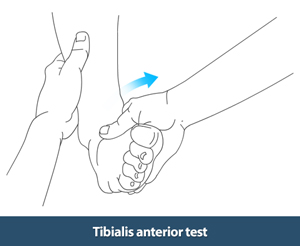
What is Anterior Tibialis Tendon Repair?
Anterior tibialis tendon repair is a surgery performed to repair a torn or ruptured anterior tibialis tendon. The rupture may occur as a result of a degenerative change or a traumatic event where the ankle and foot are pulled down and outwards forcefully, which in turn maximally stretches the tendon, causing it to rupture.
The anterior tibialis muscle originates from the front of your shinbone (tibia). It advances down the tibia and transforms into a tendon that connects the top inner section of your foot. The functions of the anterior tibialis tendon include:
- Dorsiflex (backward bending) of your ankle and foot
- Pulls your toes and foot up towards the front of your shin
- Contracts while walking to lift your toes and foot and help them clear the floor
- Assists with inversion (pulling your foot and toes inwards)
The main objective of the anterior tibialis tendon repair is to reduce pain, correct foot deformity, and restore the normal ankle and foot function and walking pattern by reattaching the torn tendon to its normal anatomical position.
Indications for Anterior Tibialis Tendon Repair
Anterior tibialis tendon repair is recommended for the following conditions:
- An acute injury or severe full-thickness tear of the tendon
- Your symptoms have lasted for more than 6 months
- You have significant loss of function and weakness in the foot
- You are an athlete and wish to return to sports soon
- Non-surgical treatments have failed to alleviate symptoms
Preparation for Anterior Tibialis Tendon Repair
In general, preoperative preparation for anterior tibialis tendon repair will involve the following steps:
- A thorough examination is performed by your doctor to check for any medical issues that need to be addressed prior to surgery.
- Depending on your medical history, social history, and age, you may need to undergo tests such as bloodwork and imaging to screen for any abnormalities that could threaten the safety of the procedure.
- You will be asked if you have allergies to medications, anesthesia, or latex.
- You should inform your doctor of any medications, vitamins, or supplements that you are taking.
- You should refrain from supplements or medications such as blood thinners, aspirin, or anti-inflammatory medicines for 1 to 2 weeks prior to surgery.
- You should refrain from alcohol and tobacco at least a week before surgery.
- You should not consume solids or liquids at least 8 hours prior to surgery.
- Arrange for someone to drive you home after surgery.
- A written consent will be obtained from you after the pros and cons of the procedure has been explained in detail.
Procedure for Anterior Tibialis Tendon Repair
Anterior tibialis tendon repair is usually performed through open surgery and involves the following steps:
- You will lie on your back on the operating table and will be administered anesthesia and intravenous antibiotics.
- A long incision of 5 to 6 inches is made along the front of the ankle and top of the foot medially.
- The underlying muscles are carefully separated to expose the ruptured anterior tibialis tendon.
- Your surgeon then brings the ends of the ruptured tendon together and repairs it using sutures and/or screws accordingly. Sometimes, a small metal “suture anchor” is placed into the bone on the top of the foot to secure the tendon back in place.
- In cases where the tendon has been severely damaged, your surgeon may take out another tendon from your foot and use it to replace all or a section of the severely damaged tendon.
- After accomplishing adequate repair of the tendon, the overlying soft tissue and skin are closed with stitches/sutures and sterile bandages are applied.
Postoperative Care and Recovery
In general, postoperative care instructions and recovery after anterior tibialis tendon repair will involve the following steps:
- You will be transferred to the recovery area where your nurse will closely observe you for any allergic/anesthetic reactions and monitor your vital signs as you recover.
- Your foot and ankle will be immobilized in a splint for the first 6 weeks to protect the wound and facilitate healing.
- You may notice pain, swelling, and discomfort in the operated area. Pain and anti-inflammatory medications are provided as needed.
- Antibiotics are also prescribed to address the risk of surgery-related infection.
- Keep the foot elevated at or above the level of your heart to help minimize swelling and discomfort.
- A walking boot or a non-weight-bearing cast is recommended for 4 weeks for partial weight-bearing of the foot after 6 weeks of immobilization with a splint.
- Assistive devices such as crutches and walkers are recommended to maintain balance and stability while walking for several weeks.
- Start rehabilitation (physical therapy) as recommended by your surgeon to improve range of motion. You should begin appropriate exercises to stretch and strengthen the foot and ankle muscles.
- Keep the surgical site clean and dry. Instructions on surgical site care and bathing will be provided.
- You can resume most of your normal activities in 4 months’ time. However, refrain from strenuous activities and lifting heavy weights for at least 6 months or longer. Gradual increase in activities over a period of time is recommended.
- Return to sports is recommended only when the foot has regained its normal strength and function and with your doctor’s approval.
- A periodic follow-up appointment will be scheduled to monitor your progress.
Risks and Complications
Anterior tibialis tendon repair is a relatively safe procedure; however, as with any surgery, some risks and complications may occur, such as the following:
- Infection
- Bleeding
- Damage to nerves and vessels
- Thromboembolism or blood clots
- Anesthetic complications
- Drug allergy
- Non-healing of the wound
- Persistent foot and ankle pain

